What we have
tested:

Perkune
Interconnect cable, 2,2 m RCA (cinch) version.
Distributor: Perkune audiophile cables,
Vilnius, Lithuania.
The
Perkune interconnect cables are
assembled in Vilnius Lithuania with the use of wire made in Italy by
Tasker and fitted with 24K direct gold plating RCA connections from Neutrik.

Cable specification by manufacturer:
Conductors: O.F.C. Red Copper
Insulation: Compact PE
Shield: Spiral covered O.F.C Red Copper
Sheath: PVC
Conductor size: 2 x 0.25 M (23 AWG)
Conductor number: 8 x 0.2 mm
Cable Diameter: 6.0 mm
Resistance: 0.075 Ohms/meter
Capacitance: 55 pF/meter
Certificate: CEI 20-22/II°, RoSH 2002/95/EC,
2011/65/UE
1.3 Meter Interconnect RCA/RCA, 245,
2.2 Meter Interconnect RCA/RCA 345.
We used the following audio test equipment on several locations:
amps:
Luxman C12 - Luxman M12,
Luxman L10,
Luxman L5,
Luxman 5C50 - Luxman 5M20,
Pioneer SA420U,
National Panasonic SA420R,
Marantz 1060,
Sansui AU-666-ONR,
Yamaha C4 - Yamaha M4,
Elektor class A amp.
tuners:
Luxman T12,
Luxman T14,
Luxman T102,
Sony ST-S361-RDS,
Yamaha T7,
CD's:
Philips CD player TDA1541,
Philips CD player bitstream,
Sony CD player,
Marantz CD player 1,
Marantz CD player 2,
Yamaha CD player,
recorders:
Teac V3000 cassette deck,
Luxman K8 cassette deck,
Luxman 5K50M
Technics cassette deck,
Zoom digital studio recorder,
record player:
Micro Seiki DQX-1000, SME, Stax, Stanton, Dynavector,
DACs:
UCS, Breeze, Philips, Cirrus, homebrew,
speakers:
Tannoy HPD315,
Tannoy Monitor Gold 15,
Tannoy 611,
Tannoy 609,
Tannoy 6' TW,
Tesla bookshelf speakers,
Technics SB-30R speakers.
cables
& accessories:
Cables: Noname1, Noname2, Puresonic, Hama Proclass1, Akai professional,
Luxman,
Hama Green, Monacor powercord S, Radiall, Amphenol, Monster,
Purecable, Monoprice,
Draka drakodaII, Siltech silver, Waff supercord A, Becker audioclass 1,
Monitor-PC1,
LTE gold, LTE diamond, Monitor-PC2, Master EMI, Quadral superwire, Nokia
professional, Panasonic, Pioneer,
and several 'homebrew' on location.
Measuring equipment:
Tektronix, Hameg, Owon, Wavetek, Trio-Kenwood, Leader-Tech, UNI-T, UniVolt,
UCS, Asus, Lenovo.
Below the Perkune cable setup in
pre/main-amp connection configuration: a Luxman C12 pre-amp connected to a
Luxman M12 power amp.
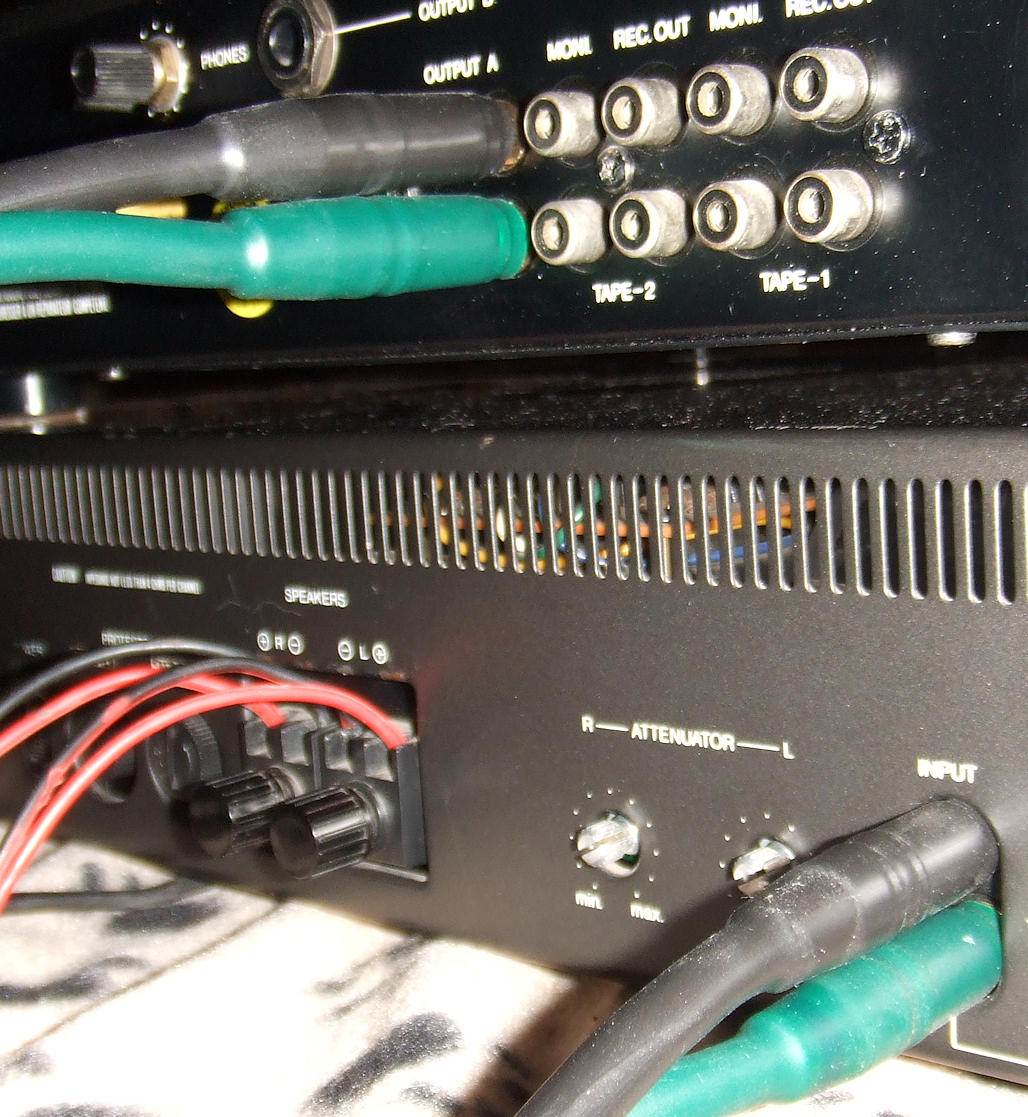
What we found:
We tested the
Perkune cable in two ways: 1. by measuring,
2. by listening and comparing with similar cables. The measuring was done
in our electronics lab and the listening was done by our audition team. We
took similar cables in the price range between 50 and
1000 per piece, in lengths from 1 M. to 2.5 M. Most have some kind of
gold coated connectors like the
Perkune and some
silver coated ones and some nickel ones.
Below the input panel of the Luxman 5C50:
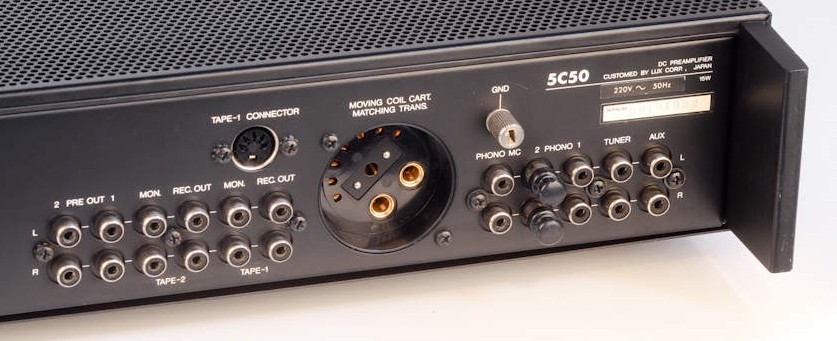
The appearance & handling of the
Perkune
cable:
This Perkune
cable looks and feels very strong and extremely well manufactured.
The cable base comes from the well known Tasker factory. The
Perkune cable has gold plated RCA plug
connectors on both sides that are protected by plastic CPE covering and it
has an arrow indicator and colour indication on the cable, these are made
by the well known Neutrik company. It handles very well and has a
significant weight. The Perkune
cable is easy to handle in most situations and connects firmly to
amplifier inputs. The
Perkune
cable is relatively rigid and can be a little surly in some
situations where limited space is a problem behind amplifiers or other
audio equipment stored in a cabinet. Advisable is to leave enough space
behind equipment to handle the cable well and not load the input plugs
with the weight of the cable, use cable support if needed, wine bottle
corks as support of cables and connectors can work well and save you from
future cable and input plug problems. The Perkune
cable is relatively uneasy to use with the notorious bottom input plug
equipped amplifiers like the well known Luxman L5 integrated amplifier:
the
Perkune cable is no exception in handling compared to other brand
cables: one should take care of the not too sharp bending of the Perkune
cable and beware of the cable weight load on the Luxman L5 input plugs,
support of the
Perkune cable is recommended in some
way, we tried it with our Luxman L5 and after some experimenting the
Perkune
cable worked well with our Luxman L5 amplifier. We also found that the
Luxman L10 integrated amplifier has the input connectors very close
together and some cables were unusable because of the fat connectors (in
our case one cable version with fat Monitor-PC connectors), but not the
Perkune: due to
the relatively slim Neutrik connectors all worked fine with the Luxman
L10, well done Perkune!
Below the notorious bottom input panel of a Luxman L5 amp:
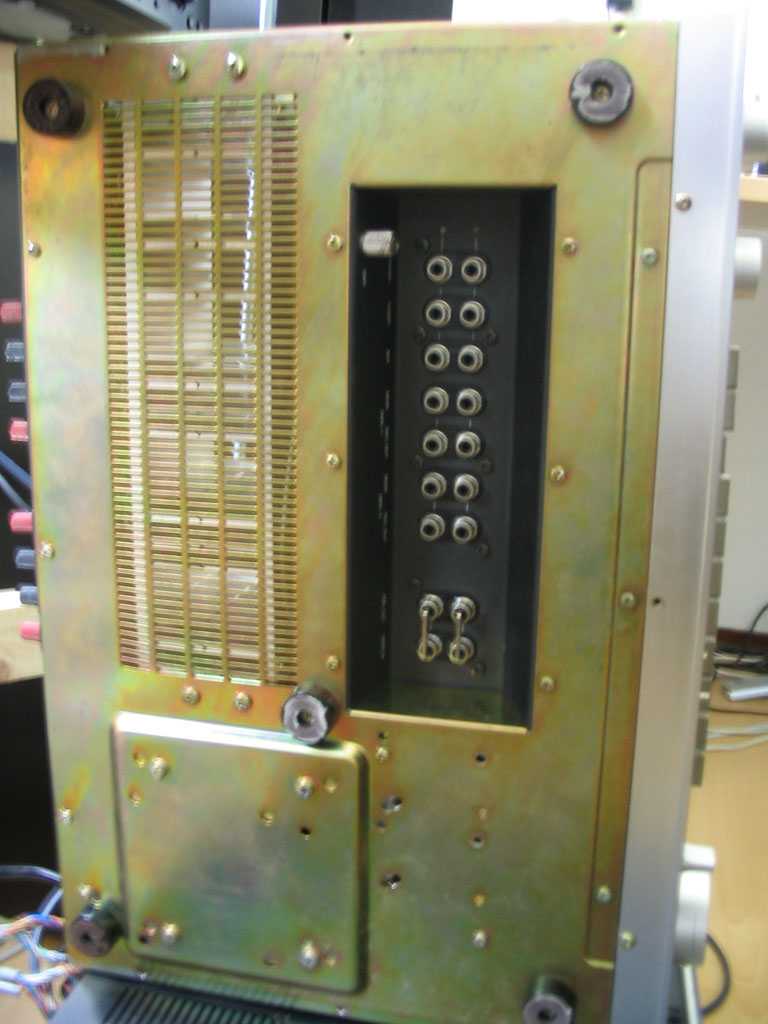
Measurements:
We made our lab measurements and found:
method 1:
Capacitance: conductor to shield: < 180 pF/meter, ~55 pF/foot.
Capacitance: shield L to shield R: < 90 pF/meter, ~25 pF/foot.
very good.
method 2:
Capacitance: conductor to shield: < 200 pF/meter, ~60 pF/foot.
Capacitance: shield L to shield R: < 90 pF/meter, ~25 pF/foot.
very good.
Resistance: core < 0.07 Ohms/meter
Resistance: shield < 0.08 Ohms/meter
excellent.
Inductance: shield < 0.02mH /total length
Inductance: core ~ 0.01mH /total length
excellent.
Frequency response: 0-10MHz flat: perfect.
Square wave response: no distortion from 5Hz up
to 2MHz: perfect.
Channel separation L-R: > 135 dB at 0.77 V RMS,
20 Hz- 20kHz, for 2.2 M. Better than 140 dB for 1M: perfect.
|
|
Audio listening
tests:
The first thing we experienced is the well made
electric connection with the Perkune cable, in
contrast with some other cables this Perkune
cable makes a firm and tight and dependable connection. No problems with
intermittent contacts, no suddenly lost signals, no problems making
contact with connectors and input plugs: it all works fine, even well
known notorious bad amplifier input sockets behave suddenly perfect
when a Perkune cable is connected, while some
other cables still make undependable audio connections with the same input: when
exchanged with the Perkune all works well!
Below the Perkune cable on the Sony CD
player:
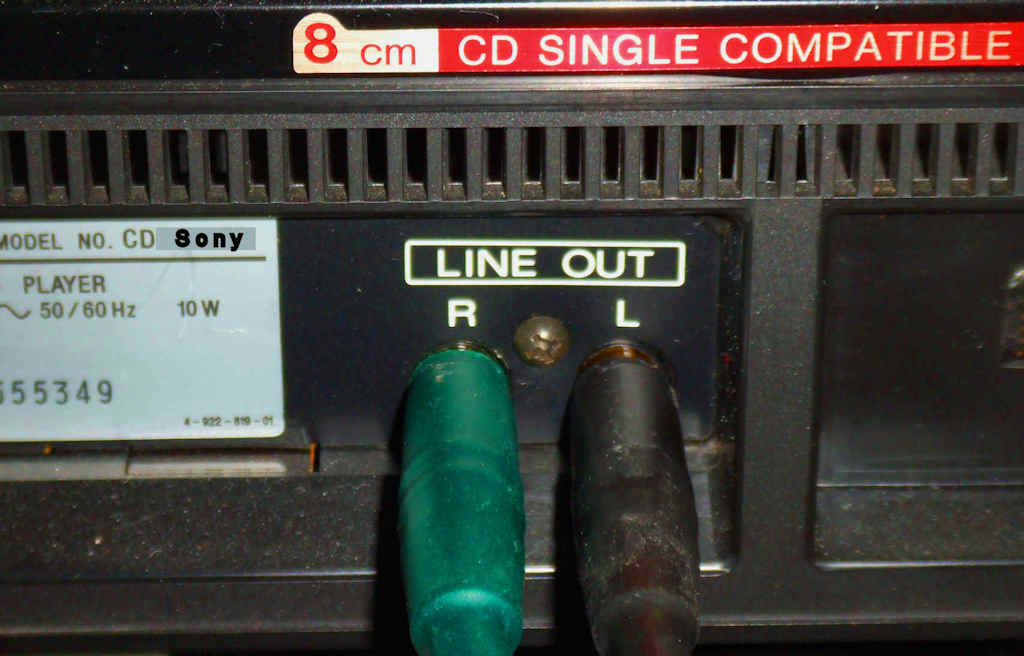
Then the
first listening session was on: with Luxman L10 integrated amplifier on
Philips and Sony CD players and Luxman T14 tuner with Tannoy Monitor Gold
15 speakers, this makes it perfectly clear: this
Perkune cable is a high quality product. The
sound is crystal clear, no distortion, well balanced sound stage, smooth
high tones and firm decent lows. Even with the sometimes little
overbrilliant dacs of the Sony CD players when the Tannoy Monitor Golds
are hooked up, the sound stage stays well balanced: brilliant highs,
controlled decent lows and mids
with highest level
of authenticity, just as a Tannoy Monitor Gold
should sound. No fatiguing effects. Specially female voices are amazing!
While some other cables are adding a little harshness to the female voice,
the Perkune doesn't do that. In this session
we used the Perkune as interconnect between the sources and the integrated
Luxman L10 amp.
Below the Perkune cable 24K gold plated
connectors
with CPE covering in two colours, we consequently
used green for the right channel:
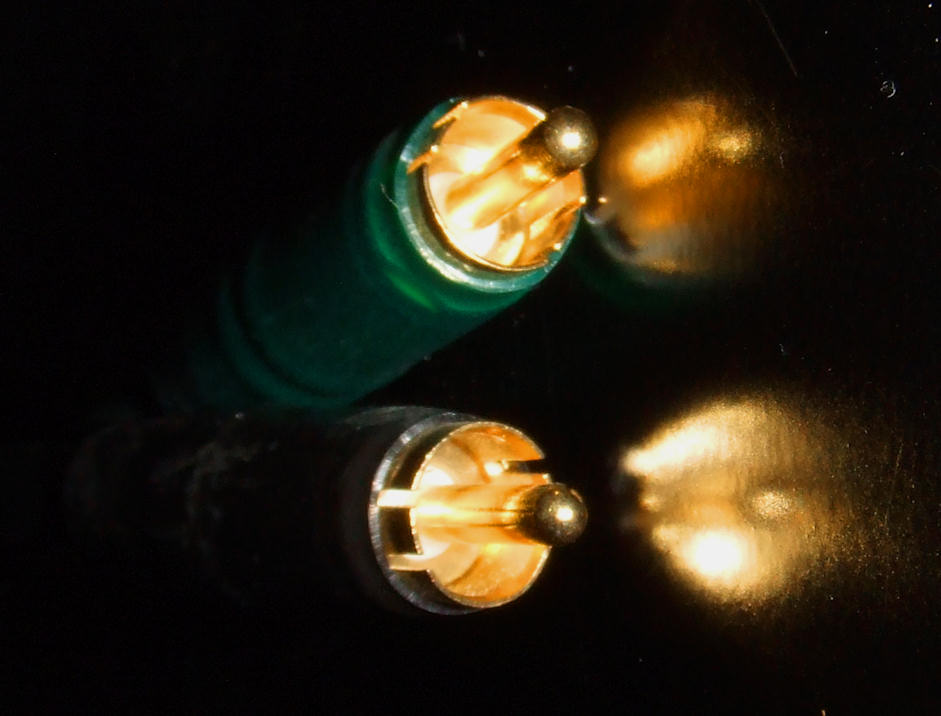
The second listening session with Tannoy HPDs, Luxman C12/M12 pre-main,
2 Marantz Cd players, Luxman T12, Teac V3000 cassette deck, and separate
dac: this configuration is more powerful and has more low frequency
capability, consequently the listening levels can be at quite high SPL. It
shows that the total setup with the Perkune
cable is in the same league as above, but with amazing dynamics. The HPDs
may have a little less authority in the mids but the dynamic sound stage
of the HPDs is overwhelming. We used the Perkune
in all kinds of possible connections. Some
cables are a little set back when it comes to dynamic soundstage, not the
Perkune: the Perkune
cable brings it all straight into your room.
Below the Perkune cable arrow
indicator:
all arrows of all cables should point to the same ground reference point:
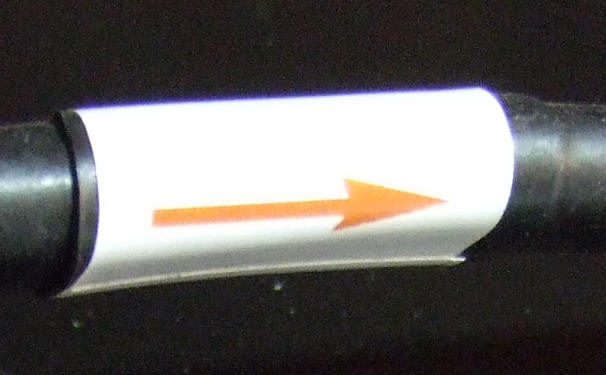
The third listening session with Tannoy Monitor Golds and the amazing
pre-main combination: Luxman 5C50 - Luxman 5M20, this was also a real
sound party! The same dynamic experience was as above with overwhelming
sound stage specially in the mid frequencies, a real winner combination,
now you experience why tons of clean sound power ready in the box is so
convenient: highest
levels of
authenticity, like a live
concert. Here we connected the Luxman 5C50 pre and Luxman
5M20
main
with the
Perkune cable: this is a winning setup. Highly recommended. Our
test cable was 2.2 M. length, that is in this setup much too long, please use
the 1.3M. length version for optimal results in such pre-main amp
connection setup.
Below the Perkune cable logo:
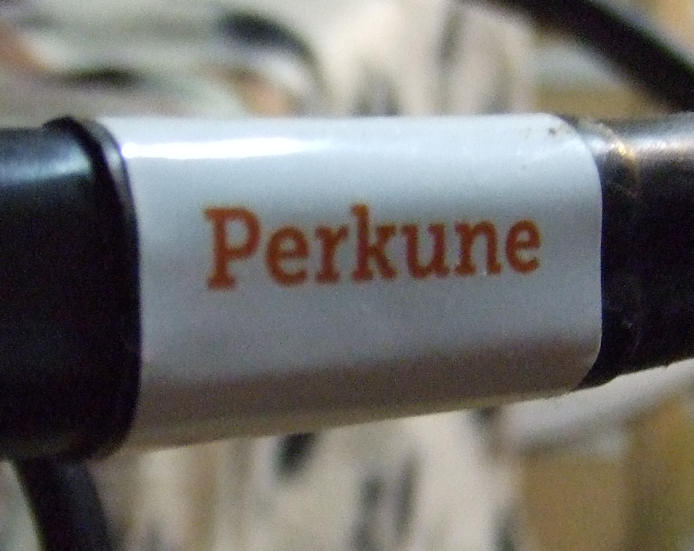
Then we did the above described L5 test and we tested some not so high-end
gear with this Perkune cable. We did the test
with a Pioneer SA420U amp, and some other amps and receivers, some
speakers like the mentioned Tannoy 611 and of course the Tannoy HPD315 in
Cheviot cabinets.
This HPD315 Cheviot is a widely spread speaker system and thats why we
involved this in the test, the Tannoy HPD315 is thus some kind of
reference. Using the
Perkune cable in combination with the HPD315
is a very good idea: it shows how great this HPD315 speaker is. The HPD315
is finally
coming into its own with the use of this high quality cable, you get the
most out of the Tannoy HPD315, even with the moderate 2x30 Watts RMS that
these kind of amplifiers can bring. Throw away your old low grade
interconnects and start using this great stuff.
In the recording studio we use Tannoys and some low-end speakers when
monitoring recordings, so here we even wanted to try the
Perkune cable with a low-end receiver and bookshelf speakers, our
test set was the vintage
National Panasonic SA420R with Technics (National Panasonic) SB-30R
speakers connected to some digital sources.
Here the Perkune cable did the job
excellent again.
We also did a final test with connecting the Perkune
cable to a vinyl record-player and
found the cable working fine with the record-player that has the output
sockets on the back of its cabinet, the record-player with SME arm with
the output sockets on the arm-base the cable had the well known handling
problems like all the heavey and thick cables have, I would rather like to
use lighter cables with the SME. Again we recommend to use the 1.3 M. Perkune
version here and not the 2.2 M. as for capacitance reasons.
Cannibalizing the cable:
Below the cut open cable,
many parts and layers of insulation and protection.
You can see the fabric wires in the wire composition that is used
for low noise contact sound damping, this kind of fabric is
also used in high quality studio grade microphone cable for
ultra stable impedance, low noise and bending security:
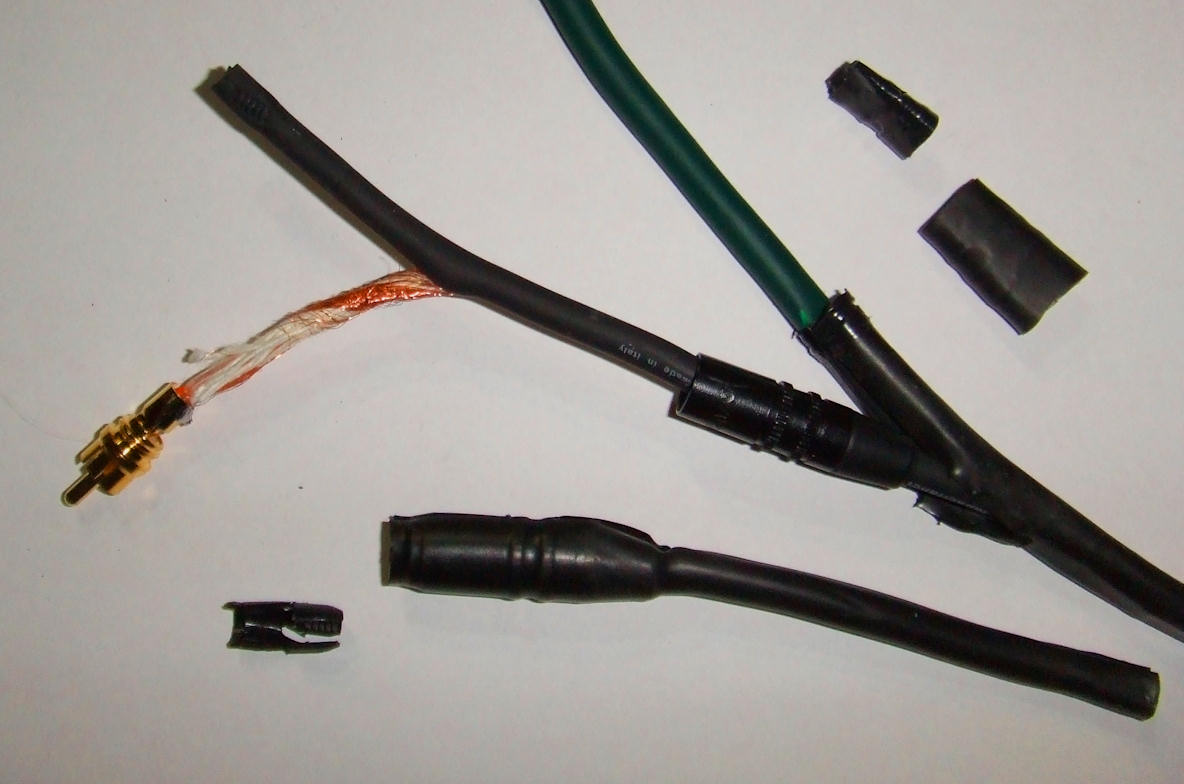
Remark:
Although its a pity to break this
nice cable, we are technicians so we want to know it all and to satisfy
our technical interest. I cut the plastics of the cable and awarded us a
look inside. On the photos you can see what we found. You can bet I
repaired the cable as much as possible afterwards: I want to be able to
keep on using it on my home audio system.
Conclusion:
This is a High-end quality product
with excellent properties.
Our
verdict:
Highly Recommended!
Manufacturer:
Contact:
audio@perkune.com
website:
http://perkune.com
address:
Perkune audiophile cables Vytenio 3-
6, Vilnius, Lithuania.
Accountability
of the measurements:
We tried to achieve high accuracy in our lab
measurements, most values are within 5% tolerance,
all measurements within 10% tolerance at ~20 deg Celsius
~55% hum. and are done with the straight cable uncoiled,
all used equipment is maintained and calibrated
by LTS®.
Acknowledgement:
Thanks
to Laurent Martin for his support and help. |









